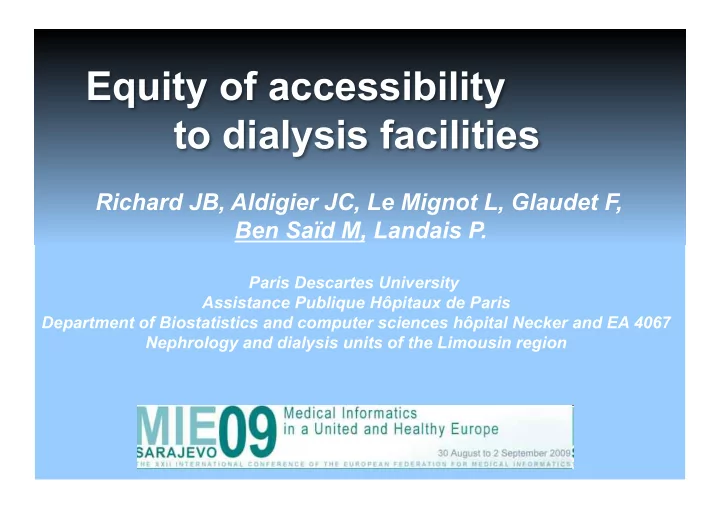

Equity of accessibility to dialysis facilities Richard JB, Aldigier JC, Le Mignot L, Glaudet F, Ben Saïd M, Landais P. Paris Descartes University Assistance Publique Hôpitaux de Paris Department of Biostatistics and computer sciences hôpital Necker and EA 4067 Nephrology and dialysis units of the Limousin region
2007 ESRD incidence : regional diversity standardized rate 139 pmp [135 - 142]
2007 dialysis prevalence: regional diversity standardized prevalence: 536 pmp [529 - 544]
Objectives Improving the quality of care leads to adapt the offer of care according to the demand and to ensure the equity of accessibility to health care facilities. Our aim here was to assess the spatial accessibility to care units, given the current distribution of dialysis modalities, and to build scenarios for optimizing travel times.
IS : organizational scheme COLLECT VALIDATE Application for data entry Tools for quality control Dynamic panels Data processor and GIS RE-ORGANIZE REPORT
Data Warehouse Incidence Transfers Prevalence a subject-oriented, Comorbidity integrated, time-variant Space and non-volatile Treatments collection of data in support of Time Age Nephropathy management's decision making process. W.H. Inmon, Prism 1995
Geographic Information System (GIS) A collection of computer hardware, software, used to efficiently capture, store, update, manipulate, analyze, and display all forms of geographically referenced information. Web use of general functions of GIS Interactivity (Flash), Dynamic connection to the data warehouse (Mysql, Php, Java), Large and unlimited access to health professionals and decision makers
Exemple de résultats SIG : dynamic representation
Observed Distances to dialysis centre
Observed travel times to dialysis centre
Methods: exploring accessibility Description of observed time to care unit : • Geographically: inter-regional differences • according to the modalities of treatment: Dialysis Center, Medicalized dialysis unit, Autodialysis unit Travel times: estimated via Loxane Way Server and Google How a spatial approach might aid for health organization? • Example of scenarios of modification of the offer of care
Methods: Two floating catchment area • “Floating catchment method ” to identify zones lacking dialysis structures. • A circle (catchment) around each centroid is the basic unit for calculating the ratio physician/ population. • The rayon represents the “reasonable” distance to cover towards the care unit • Moving the circle here and there for identifying the zones lacking dialysis structures.
Two floating catchment area
Observed travel times: centres
Observed travel times: autodialysis
Observed vs estimated travel times
Example of scenarios for an aid to decision making ascertaining the geographical zones of low accessibility (time>threshold) Evaluating the population concerned evaluating the number of ESRD patients concerned
Modelling offer to demand of care for ESRD treated by dialysis
Modelling offer to demand of care for ESRD treated by dialysis
Modelling the offer to the demand of care for ESRD treated by dialysis
Discussion • The remoteness from a dialysis unit has important implications for patients considering the impact on their quality of life since they need accessing their dialysis centre three times a week. • It also impacts the economic costs of reimbursements for the national Medical insurance. • Transports to dialysis units represent an important part of the dialysis costs.
Discussion: limitations • the feasibility of creating in-centre units is bound by economical constraints and by the difficulty to recruit physicians in rural areas. • If 90% of patients are currently treated in the nearest unit, it doesn’t mean that they will opt for changing of dialysis unit in case of creation of a new one. • We considered no limitation in adapting patients’ recruitment capacity for a given unit.
Discussion: limitations • A small fraction of still working patients can’t easily choose between different dialysis units. • Finally, the scenario supposes that ESRD patients are always treated according to the more appropriate modality, a status which has not been clearly established yet. • Future scenarios are in process to analyse the impact of modifying the distribution of treatment modalities, evaluating for instance the ability to develop peritoneal dialysis for the treatment of elderly at home.
Discussion • It is critically important to articulate the supply and demand of health services and to understand how these two factors might better match in the future in order to provide appropriate accessibility for the population, • with a continuous monitoring of health care planning based on registry data. • This work highlights organizational issues that will be encountered in the near future according to ageing. • It emphasizes important issues related to health care planning to cope with the accessibility to dialysis facilities considering the evolving patterns of ESRD epidemiology.
Acknowledgments: Members of SIMS-REIN in the Limousin region are warmly acknowledged for their cooperation: V Allot, M Diaconita, C Lagarde, P Peyronnet, B Champtiaux-Dechamp, C Achard-Hottelard, JP Rerolle, M Essig, F Bocquentin, M Wong Fat, R Boudet, P Honoré, JM Poux, and for the SBIM, L Toubiana, JP Jais, X Ferreira and JP Necker. This work was supported by a grant from Paris Descartes University EA 4067 and Agence de la Biomédecine
Recommend
More recommend